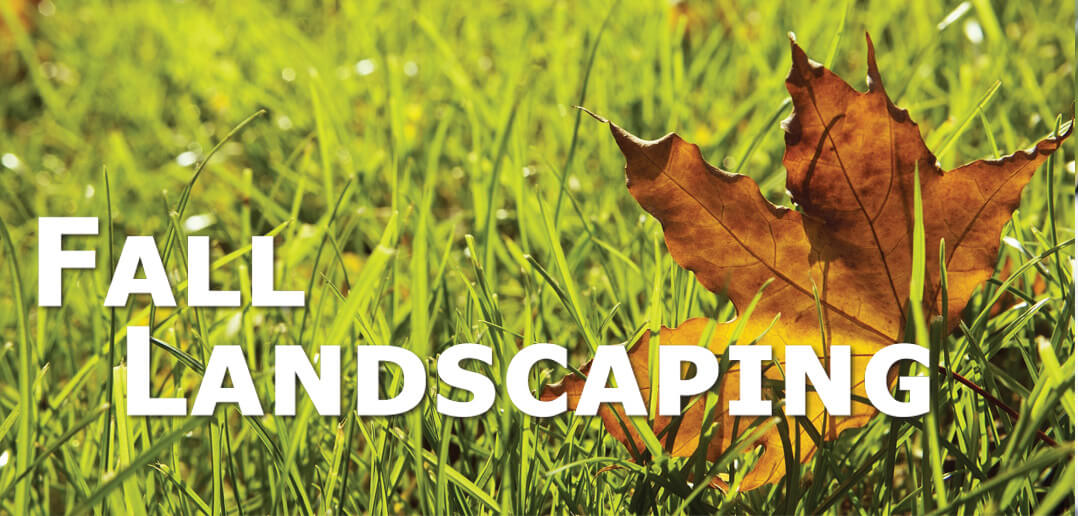Fall Landscaping in Omaha, NE
As we are entering the time of year where the green is giving way to a gorgeous display of autumn hues, it also signals that it’s go time on yard projects in an effort to get everything in order before the arrival of winter. In the fall we often focus on tying up loose ends and addressing anything that’s been waiting in the wings because it’s best done this time of year in addition to the annual list of general grounds maintenance tasks.
Preparing your lawn for winter will ensure that it not only survives, but thrives next season. This includes clearing all debris, especially leaves, and applying a winterizer. A winterizer is a late fall fertilizing treatment designed to help lawns store more food for winter survival and to encourage thick, rapid growth and rooting in the spring. Keep in mind that this isn’t meant to encourage fall growth of grass; it is the finishing touch now for a good start in the spring. Early fall fertilizing, which can still be done in October too, is widely considered the most important fertilizer of the year for northern grasses. The best time to apply a winterizer is after the grass stops growing in the fall, but while it is still green. In Nebraska, this will be sometime in late October all the way up until mid- to late November in some instances. Basically, when you put the mower away for the year, apply winterizer to your lawn.
Aerating and overseeding are also a good idea. This will also promote root growth; the stronger the root system, the better chance your lawn will have to withstand the harsh winter conditions in Nebraska every year. Also, fall is a great time for planting trees—it may seem strange, but especially after the leaves have fallen off. As with your lawn, this gives the tree a chance to grow a strong root system prior to dormancy while not being stressed out trying to create leaves. Preparing your lawn for the winter is fairly easy and not terribly time consuming, but it is also something that is often overlooked and with detrimental results.
QUICK TIP: Preparing your living landscape for winter is extremely important. Ensuring the root system is adequately covered is key to the long term health of the plant. Where most homeowners fail is in providing enough water to the plant’s root ball going into winter. Just because there are no leaves on the plant doesn’t mean the plant is fully dormant. Evergreens, both broadleaf and needle, need plenty of water going into winter. As long as the ground isn’t frozen solid and still accepts the moisture without running off you should maintain regular watering.
As for landscaping projects, the optimal approach is two-fold: handle what needs to be done now and plan for the coming year (yes, already!).

Marcus Hellwege
Great Plains Landscaping & Design
Marcus Hellwege, owner of Great Plains Landscaping & Design and Great Plains Epoxy, offers the following advice:
“Meet with your landscape designer and create a good design and landscape plan for the winter and the following year. This will help you stay within your budget and will also help your indoor/outdoor space flow as well as allowing for easy maintenance during those tough winter months. Fall is the best time to plant trees and shrubs too, so get on the calendar early this fall to get your plans in place.
I’m often asked if it’s a good idea to trim shrubs and grasses back in the fall, and my advice is to wait until early spring for a trim as the leaves provide protection for plants throughout the winter. If you do move forward with a fall cleanup make sure you mulch around the crown of the plants for extra protection. Finally, make sure your spaces are neat and tidy prior to winter so that your plants and beds in close proximity to your porch, walkways, driveways and any other point of access do not get damaged during the snow removal process.”
He adds, “With the addition of our epoxy flooring division, we are getting a lot of requests for outdoor flooring space. Most often this is due to the fact that the homeowner’s concrete has matured and looks a bit tired and worn down. We have helped numerous homeowners’ vision become a reality for these spaces by resurfacing with epoxy and concrete overlay. For outdoor spaces, we offer everything from flake to mica and lava flow. Did I mention this option is a fraction of the cost of replacing the current flooring?
Whether it’s landscaping or flooring, get on the calendar with us now as dates are filling up. We would be happy to come out and help you get a plan in place.”
QUICK TIP: Don’t forget, the first thing to have done prior to a major project near the edges of your property is a boundary survey to establish exactly where the property lines lie. The money that you spend in your landscaping project is an investment in the overall value and appearance of your property, but if you don’t own the land you are improving you are effectively investing in someone else’s property value.
With the exception of a few select things, the majority of projects that can be done during the regular growing season can be done in the fall too. Similar to landscaping in the spring, when it comes to assessing what should take priority some projects are best suited for late summer and fall. Renovating your lawn can be done at any time during the season, but fall is the optimal time. The soil is still warm, the rains are a bit more frequent, the sun does not have the scorching effect it does in July and August, and finally you’re not competing with heavy weed growth and turf feeding insects. The same holds true for landscape projects. You will generally receive a better value on your landscape material in the fall as growers and retailers are offering end-of-season discounts. You’re also getting a full year’s worth of growth for the cost of the plant when calibrated in the early spring.
When renovating landscape it is important to remember that major bed renovations will also require adapting your irrigation system. Sprinkler heads that are trapped inside new or existing landscapes will reduce the coverage of turf areas causing stress to the turf and even over watering some plant material.
While you are updating or adding landscape beds consider irrigating the beds with drip irrigation. When properly installed, drip irrigation can enhance the plant’s health and ensure that your landscaping will thrive for years to come. When installing foundation border landscapes, drip irrigation is a great addition. Drip uses approximately 50% less water than aerial delivery systems, it is more precise, more controllable, and requires less weeding of landscape areas. With the drier weather Eastern Nebraska has been experiencing it is also a great way to keep the soil moist around the foundation of your home to assist in preventing foundation shift.
Fall is also a great time to have your irrigation system audited. If your irrigation system is older and has not been tuned up in at least the last two years, it is time for a check-up. Just as you perform maintenance to your car, furnace/AC or your lawn mower, your irrigation system also needs a little attention from time to time. Always keep your eyes out for the obvious such as broken heads, leaky valves, squishy areas in the lawn, but also look for signs of stress or uneven watering. If there are areas of your yard that look greener than others or you have high and low areas consider giving your irrigation professional a call as this could be something as simple as cleaning a nozzle obstruction or it could be a sign that your irrigation system is not designed correctly. Proper water distribution (matched precipitation) is a very important part of your sprinkler system’s operation and your turf’s health.
Since outdoor living spaces are still all the rage moving into fall, you may also be considering this type of project yet this year. In terms of benefits, adding square feet to your home by way of outdoor living space enhances the value and your enjoyment of your property. There are many ways homeowners can improve or add interest to outdoor living and entertaining spaces to make them comfortable and inviting.
With cooler temperatures, fireplaces are being fired up all across town too. While most people don’t think about their fireplace during times of the year when we are enjoying warmer temperatures, masonry repairs are ideally performed in warm weather so that the mortar sets up correctly. We may get lucky and still have a little time yet this month in case you run into any complications, so if you haven’t already inspected your fireplace, and the part of the chimney that’s exposed to the elements in particular, you’ll want to do that as soon as possible. For optimal function as well as the best possible color match to the existing brick, you’ll want to have a professional help you find the right materials and in most cases perform the repair too.
The same holds true with concrete, tile, and just about any other process that requires a bonding agent to cure, with projects of that nature unable to be completed once winter weather has set in. When you’re doing all of your fall maintenance, it’s a great time to assess your entire property and take note of anything that’s damaged or deteriorated. Key areas you’ll want to focus on are structures, design features, patios and decks, driveways, walkways, stairs, curbing/edging/bordering, and retaining walls. This will be helpful in planning for what will take priority next spring if it’s unable to be addressed yet this fall.
With the fall season approaching and the days becoming shorter, now is also definitely a good time to look at installing an outdoor lighting project. Some of the key benefits of outdoor lighting include:
Safety
Outdoor lighting can add safety in a variety of ways. Illuminated walkways ensure that people navigate these areas safely. Use of zone lighting adds light to areas of your yard and landscape for nighttime use. Zone lighting can be effective for lighting a patio, deck, garden, pool area or outdoor seating area. Illuminating sidewalks, driveways, garages and entryways aids in keeping your landscape safe after dark. The more lights, the safer your outdoor areas will be.
Comfort
Extend your living areas by lighting your outdoor landscape. If you have a deck or patio with seating, adding comfortable and attractive lighting will enable you to use these areas after dark. The ambiance of outdoor seating can be pleasant and inviting, especially when you feature attractive outdoor lighting that adds to your outdoor decor.
Design Features
Showcase and highlight specific areas of your landscape with decorative lighting. By installing up lighting around your landscape in various spots, you pull the eye to these areas and display them attractively. Landscape lighting is also an effective way to display planting areas or flower gardens. Installing mood lighting along outdoor buildings adds pleasant splashes of light in your landscape too. You can even add low-voltage exterior lights to trees and shrubs outdoors to illuminate planting areas and add beautiful accents to your exterior areas.
Curb Appeal
A well-lit home gives a well-maintained impression to the entire neighborhood. Your house will appear warm and inviting as it sits quietly on your property. In contrast to a dark and drab home, your illuminated home will draw people in and offer a warm refuge for family and friends.
Cutting-Edge Technology
There have been some impressive advancements in outdoor lighting over the past few years. With LED technology there is much less energy consumption and many systems are equipped with Bluetooth technology and apps for both Android and Apple IOS, putting the control of your new lighting system at your fingertips.

Travis Lerdahl
Natural Night-Scapes
“Color changing outdoor lighting has been very popular among my clients,” says Travis Lerdahl of Natural Night-Scapes. “It really enhances the plants and plays up the prominent features of the property nicely. Many also have fun with setting the festive holiday mood by changing the lighting scheme accordingly. The best part is that you can operate the lighting system right from your smartphone or tablet!”
He adds, “From the no-cost consultation, to the design, all the way to the annual check-ups, Natural Night-Scapes will be there the whole way. For those who are on the fence about lighting and are unsure of its potential, we offer a free demo in which we will generally focus on one area of the property. We’ve found that setting up a few temporary fixtures for a few nights really goes a long way in helping property owners decide on the direction they want to go.”
To recap, here are a few key guidelines for fall landscaping in general:
Turf Management
Fall is a great time to plant just about anything. From a turf management perspective, fall is a great time for aeration and over seeding. The best seed window lasts until October 15th. If you do not intend to aerate your yard in the fall then consider slit seeding or drilling the seed. Either one of these methods implants the seed in the soil and protects it from neighborhood friends like birds, squirrels and rabbits. Seeding in the fall usually requires less water to establish the newly planted seed. Another advantage to fall over seeding is weed control. Weeds are at the end of their growing cycle.
Plant Trees (Especially Fruit Trees)
Fruit trees should be planted in the fall or very early spring. Planting fruit trees for a fall landscaping project will be rewarding for years to come. Decide what type of tree you want to plant and make sure that it will survive in your zone and fit into your landscape once fully grown. Many fruit trees come in dwarf varieties and can be pruned to maintain a smaller size. Look for a young and healthy tree at a local nursery. Follow planting recommendations for your variety of tree.
Winterizing
One of the most important things to keep in mind in regards to your underground irrigation system as fall draws near is the winterization process. Whether you choose to use the gravity drain method or blow the system out with pressurized air you want to make sure you or your irrigation professional winterizes the system correctly. An improper winterization can lead to expensive repairs in the spring. While it is not required on most residential systems, winterizing with pressurized air is the only way to ensure all the water has been evacuated from your system. If you blow-out your own irrigation system make sure to never exceed 70 psi.
Outdoor Lighting
With the fall season approaching and the days becoming shorter now is a good time to look at installing an outdoor lighting project. When you spend time outdoors with family and friends, you’ll need adequate outdoor lighting to illuminate your landscape areas. Whether you’re sitting outside on a deck or patio or you wish to place a spotlight on a specific area of your yard, outdoor lighting can create a very pleasurable and inviting space.
As you can see, there’s much more to be done on a property during the fall than one might think. While there are some general rules of thumb to follow, every yard is different as are the possibilities to explore, so what’s on the to-do list will vary. Since we only have precious little time until winter weather is upon us, if there’s anything you have yet to tackle, now is the time!

